
D1 and D2 pipework regulations govern the installation of discharge pipes from safety devices, ensuring compliance with building standards and water safety requirements. These regulations are critical for maintaining system integrity and preventing hazards. Proper sizing, material selection, and compliance with WRAS/ACS approvals are essential to meet legal and safety standards.
Overview of Pipework Regulations
Pipework regulations, including D1 and D2 standards, are designed to ensure safe and reliable installations, particularly for discharge pipes from safety devices. These regulations outline requirements for sizing, material compatibility, and compliance with building standards like G3. Proper installation and compliance with WRAS/ACS approvals are essential to prevent hazards and meet legal obligations. The regulations also cover aspects like pressure testing, documentation, and certification, ensuring systems operate efficiently and safely. Adherence to these guidelines is crucial for maintaining water safety and avoiding potential failures in pipework systems.
Importance of Compliance with D1 and D2 Standards
Compliance with D1 and D2 standards is crucial to ensure the safety, efficiency, and reliability of pipework systems. Non-compliance can lead to system failures, health risks, and legal penalties. These standards provide clear guidelines for sizing, materials, and installation, minimizing hazards and ensuring adherence to building regulations. Proper compliance also ensures water quality and prevents contamination. By following D1 and D2 standards, installers can guarantee that systems operate safely and efficiently, meeting both regulatory and environmental requirements. Adherence to these standards is essential for maintaining public health and safety in plumbing and water supply systems.
Key Components of D1 and D2 Pipework
Key components of D1 and D2 pipework include discharge pipes, materials like copper, and compliance with WRAS/ACS standards, ensuring safe and reliable systems.
Definition and Scope of D1 Pipework
D1 pipework refers to the discharge pipe from a safety device, such as a temperature or pressure relief valve, to the tundish or point of discharge. It is typically metallic, with copper being the most common material due to its durability and compatibility. The scope of D1 pipework is governed by building regulations, ensuring proper sizing, material compliance, and safe installation practices. It must adhere to specific standards to prevent hazards and maintain system integrity, with requirements outlined in regulatory documents and approvals like WRAS/ACS.
Definition and Scope of D2 Pipework
D2 pipework is defined as the discharge pipe running from the tundish to the point of final discharge, typically into a drain or soakaway. It must maintain a continuous fall to ensure proper flow and prevent back-siphonage. Materials used for D2 pipework are specified by regulations, often metallic or approved plastics, ensuring durability and compliance. The scope includes specific sizing requirements, maximum allowable lengths, and restrictions on bends to maintain hydraulic performance. Compliance with Building Regulations and G3 standards is mandatory to ensure safe and efficient operation, preventing potential hazards and system failures.
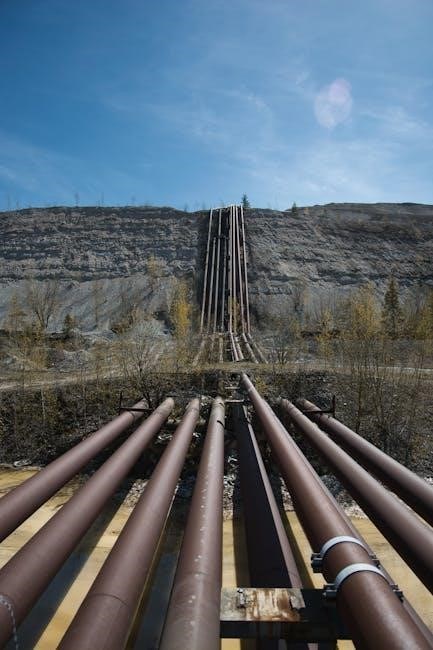
Regulatory Requirements for D1 and D2 Pipework
Regulatory compliance for D1 and D2 pipework is essential, adhering to G3 Building Regulations and WRAS/ACS approvals to ensure safety and meet legal standards effectively always.
Building Regulations and G3 Compliance
Building Regulations and G3 compliance are critical for D1 and D2 pipework installations. G3 regulations specify requirements for discharge pipes from safety devices, ensuring proper sizing and material compatibility. Compliance involves adhering to guidelines for pipe diameters, lengths, and bends to maintain flow efficiency and prevent blockages. Specific rules, such as maximum allowable bends and continuous fall requirements, must be followed. Non-compliance can lead to system failures and safety hazards. Proper documentation and certification are essential to verify adherence to these standards, ensuring installations meet legal and safety requirements effectively.
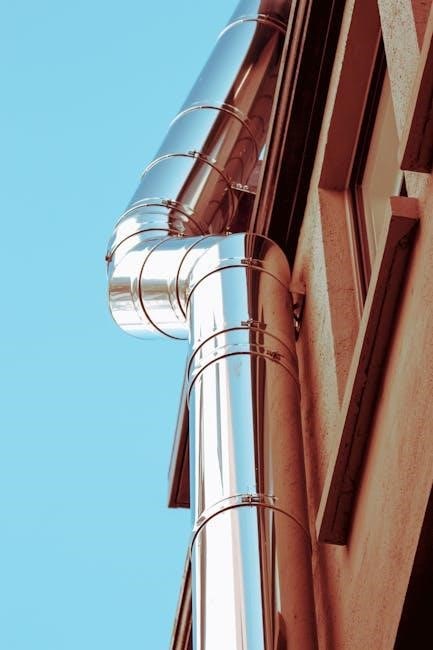
Material Specifications and Compatibility
Material specifications for D1 and D2 pipework must meet strict standards to ensure durability and safety. Copper piping is commonly used for D1 due to its robustness and suitability for high-temperature applications. For D2, materials like PE100 are preferred for their resistance to corrosion and flexibility. Compatibility with system components is crucial, ensuring no adverse reactions occur. All materials must comply with EN standards and WRAS/ACS approvals, guaranteeing water safety and system integrity. Proper material selection prevents leaks and failures, ensuring long-term reliability and compliance with regulatory requirements.
Design and Installation Guidelines
D1 and D2 pipework design must prioritize accurate sizing and layout to ensure optimal flow and compliance. Installation requires precise measurements and adherence to safety protocols to minimize risks.
Sizing and Length Calculations for D1 and D2 Pipework
Sizing and length calculations for D1 and D2 pipework are critical to ensure proper flow rates and pressure drops. Factors such as fluid type, flow rates, and system pressure must be considered. For D1 pipework, the discharge pipe from safety devices must be sized to handle the maximum flow rate without excessive pressure drop. D2 pipework, connecting the tundish to the drainage system, requires precise length and slope calculations to maintain a continuous fall. Calculations must comply with Building Regulations and G3 standards to prevent blockages or reduced efficiency. Proper sizing ensures safety and system performance.
Installation Best Practices
Installation best practices for D1 and D2 pipework emphasize adherence to Building Regulations and G3 compliance. Proper support and alignment are crucial to prevent sagging and stress on connections. Use of compatible materials, such as copper pipes for D1, ensures durability and resistance to corrosion. Avoiding excessive bends and ensuring a continuous fall for D2 pipework prevents blockages and maintains flow efficiency. Regular inspection during installation and post-installation testing are essential to identify and rectify any issues promptly. Following these practices ensures reliable performance and compliance with safety standards.
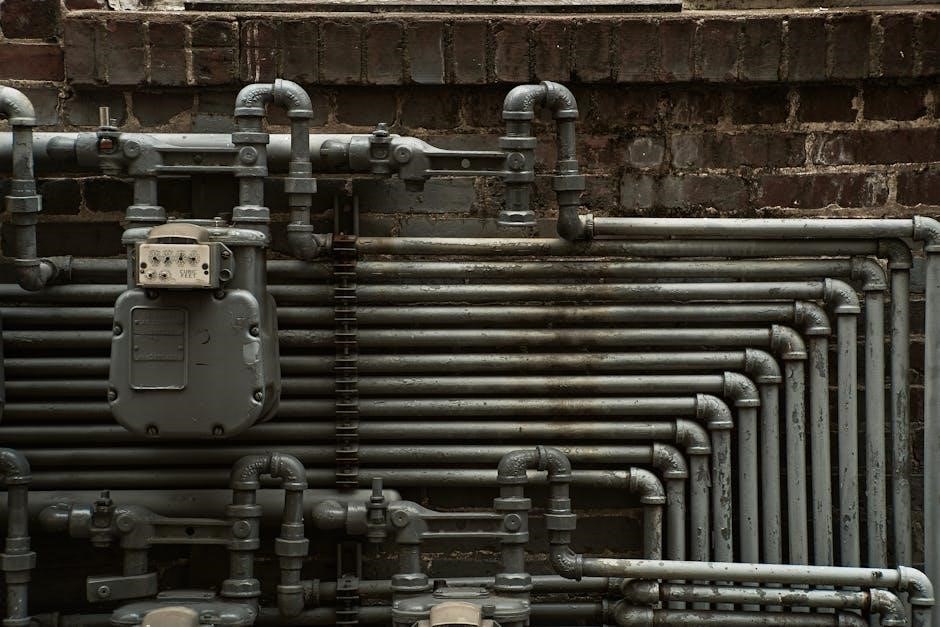
Testing and Inspection Procedures
Testing and inspection procedures for D1 and D2 pipework involve pressure testing, WRAS/ACS compliance checks, and thorough documentation to ensure system integrity and safety standards.
Pressure Testing Requirements
Pressure testing is a critical step in ensuring the integrity of D1 and D2 pipework systems. It verifies that pipes can withstand operational pressures without leaks or failures. Tests typically involve filling the system with water or air and maintaining a specified pressure for a set duration. Compliance with WRAS/ACS standards ensures materials and joint integrity meet safety requirements. Proper documentation of test results is essential for certification and regulatory approval. Regular testing also helps identify potential weaknesses, ensuring long-term reliability and safety of the pipework installation.
Documentation and Certification

Proper documentation and certification are essential for ensuring compliance with D1 and D2 pipework regulations. All installations must be accompanied by detailed records, including material specifications, test results, and installation certificates. Compliance with WRAS/ACS standards requires certification from approved bodies, verifying that materials and installations meet safety and performance criteria. Documentation must also include pressure test results, joint integrity reports, and system design specifications. Maintaining accurate records ensures traceability and accountability, while certification provides assurance of compliance with legal and regulatory requirements. Proper documentation is critical for audits, inspections, and future system maintenance.
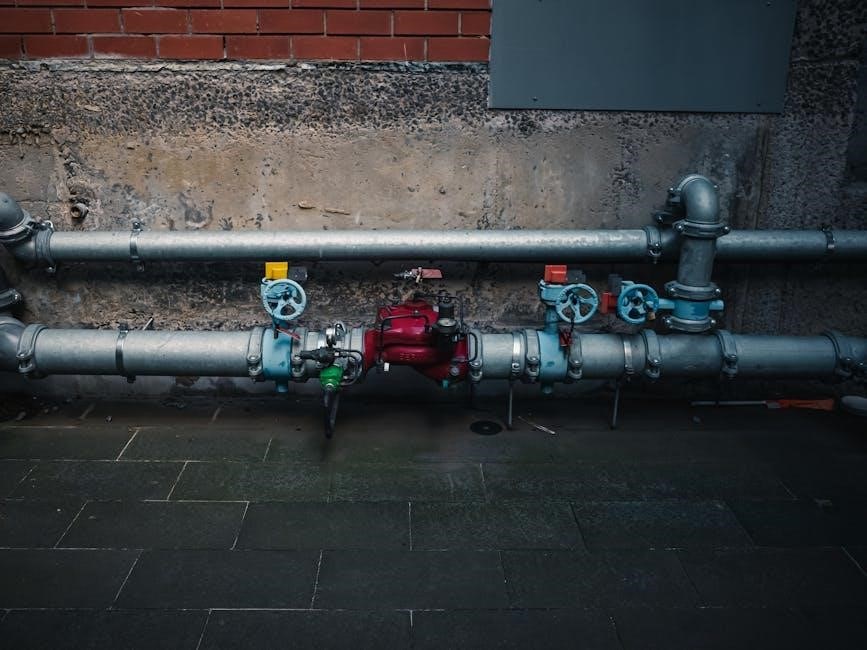
Water Safety and WRAS/ACS Approvals

WRAS and ACS approvals ensure compliance with water safety standards, verifying materials and installations meet regulatory requirements for safe water supply and system performance in D1 and D2 pipework.
Role of WRAS in Pipework Compliance
The Water Regulatory Advisory Scheme (WRAS) plays a pivotal role in ensuring pipework compliance by providing approvals for materials and fittings used in water supply systems. WRAS certification guarantees that products meet rigorous standards for safety, durability, and water quality, minimizing contamination risks. This is particularly crucial for D1 and D2 pipework, where compliance with WRAS standards ensures the integrity of discharge pipes from safety devices. By adhering to WRAS guidelines, installations maintain legal and safety requirements, safeguarding public health and environmental protection. Proper WRAS compliance is thus essential for reliable and secure pipework systems.
ACSApproval for D1 and D2 Pipework
ACSApproval is a certification scheme ensuring installers meet stringent standards for gas and water system installations, including D1 and D2 pipework. It verifies competency in safety, efficiency, and regulatory compliance. ACSApproved installers undergo rigorous training and assessments, guaranteeing adherence to industry best practices. This certification is vital for maintaining system integrity and ensuring installations meet legal requirements. By requiring ACSApproval, the quality and safety of D1 and D2 pipework installations are upheld, protecting both users and the environment. This standard is a cornerstone of professional installation services in the UK.
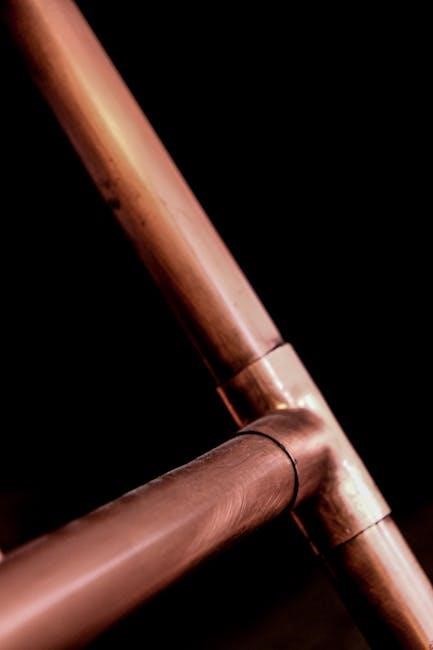
Case Studies and Practical Applications
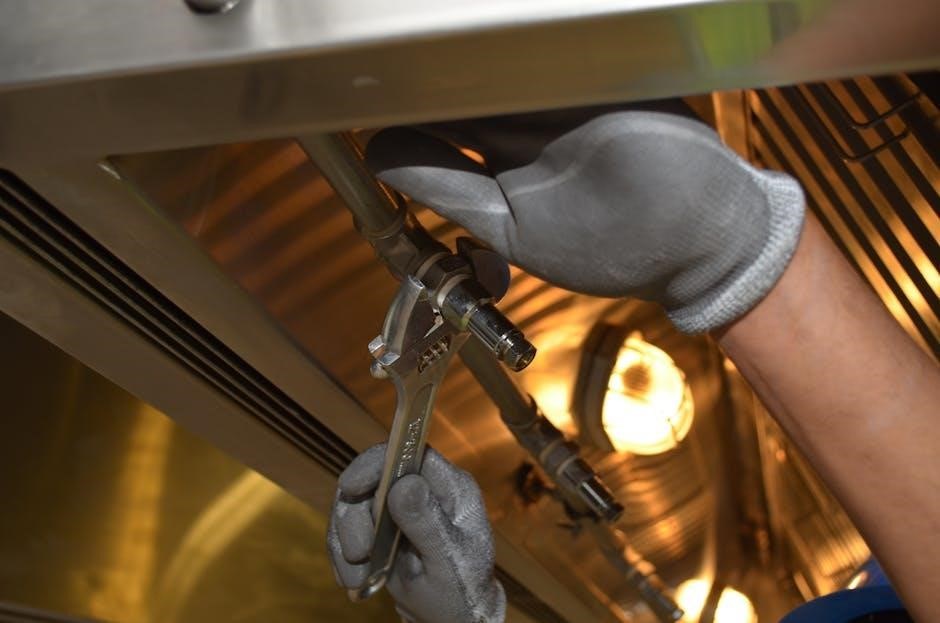
Real-world applications demonstrate D1 and D2 pipework regulations in action. Case studies highlight successful installations, ensuring safety and compliance in various systems and environments.
Real-World Examples of D1 and D2 Pipework Installations
A G 1/2 temperature relief valve with a discharge pipe (D2) having 4 no. bends is a common installation, adhering to G3 Building Regulations. In another case, a 28mm copper pipe (D2) was installed for a 7m discharge system, ensuring compliance with G3 standards. Residential systems often use copper pipes for D1 and D2, while industrial setups may employ PE100 pipes for durability. These examples highlight practical applications of D1 and D2 pipework, emphasizing the importance of proper sizing and material selection to meet safety and regulatory requirements;
Lessons Learned from Compliance Scenarios
Compliance scenarios highlight the importance of adhering to D1 and D2 pipework regulations. Proper sizing and material selection prevent system failures and ensure safety. Non-compliance can lead to legal issues and safety hazards. Best practices include regular inspections and adherence to WRAS/ACS approvals. Real-world examples demonstrate that ignoring regulatory requirements can result in costly rework and potential dangers. Therefore, strict compliance with guidelines is essential to avoid pitfalls and ensure reliable, long-term performance of pipework systems.
D1 and D2 pipework regulations are essential for ensuring safety, compliance, and efficiency in plumbing systems. Adherence to these standards prevents hazards and guarantees long-term performance. Future trends will focus on enhancing materials and installation practices to meet evolving safety demands.
D1 and D2 pipework regulations ensure safe and compliant discharge systems for safety devices. Compliance with Building Regulations G3, WRAS/ACS approvals, and proper sizing is essential. Materials like copper are preferred for D1 pipework, while D2 requires continuous fall and minimal bends. Pressure testing, certification, and adherence to EN standards guarantee system integrity. Non-compliance risks legal penalties and safety hazards. Proper installation practices, material compatibility, and regular inspections are critical. Understanding these regulations ensures reliable and safe plumbing systems, meeting both legal and safety standards effectively.
Future Trends in Pipework Regulations
Future trends in D1 and D2 pipework regulations emphasize enhanced water safety, sustainability, and digital monitoring. Stricter material standards and energy-efficient designs are expected to dominate. Advances in WRAS/ACS approvals will prioritize eco-friendly materials and reduced waste. Digital tools for real-time system monitoring and compliance tracking will become standard. Global harmonization of pipework standards is anticipated, ensuring uniformity across regions. These trends aim to improve safety, reduce environmental impact, and streamline regulatory compliance, fostering innovation in pipework design and installation practices.